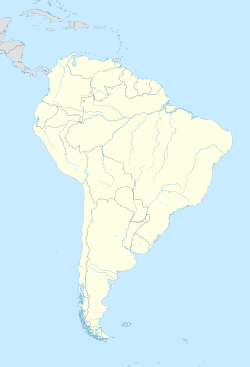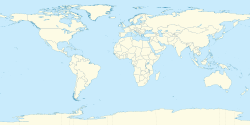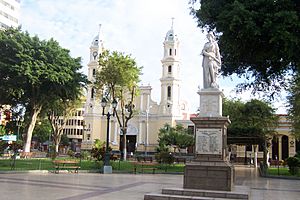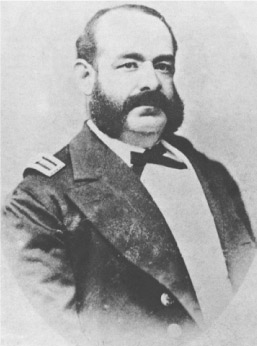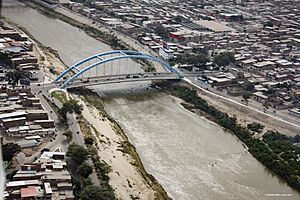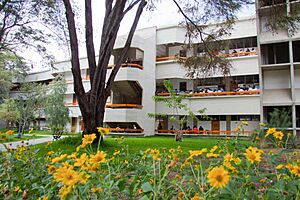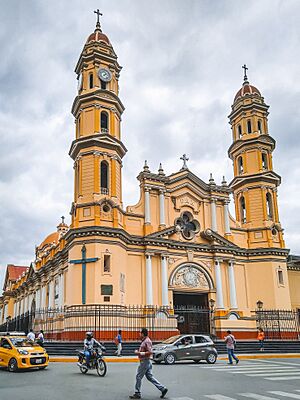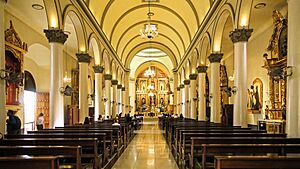Piura facts for kids
Quick facts for kids
Piura
San Miguel de Piura
|
|||
|---|---|---|---|
|
Saint Michael the Archangel Cathedral
Piura University
Miguel Grau Stadium
Miguel Grau Oval
A street for Hotel Tacna
Piura River and Barrio Norte area's panorama
|
|||
|
|||
| Nickname(s):
La Primera Ciudad
(The First City) La Ciudad del Eterno Calor (The City of The Eternal Heat) |
|||
| Country | Peru | ||
| Region | Piura | ||
| Province | Piura | ||
| Founded | 1532 | ||
| Founded by | Francisco Pizarro | ||
| Area | |||
| • Total | 621.2 km2 (239.8 sq mi) | ||
| Elevation | 55 m (180 ft) | ||
| Population
(2020)
|
|||
| • Total | 630,244 | ||
| • Estimate
(2020)
|
630,000 | ||
| • Rank | 7th | ||
| • Density | 647/km2 (1,675/sq mi) | ||
| Demonym(s) | Piurano | ||
| Time zone | UTC/GMT-5 | ||
| Area code(s) | 73 | ||
| Website | munipiura.gob.pe | ||
Piura is a city located in northwestern Peru, by the Piura River. It is the capital city of the Piura Region and the Piura Province. With over 630,000 people (as of 2020), it's the 7th largest city in Peru. Piura is about 981 kilometers (609 miles) from Lima, Peru's capital, and is close to the border with Ecuador.
In 1532, the Spanish conqueror Francisco Pizarro founded San Miguel de Piura here. It was the first Spanish city in Peru and the third in South America. Piura declared its independence from Spain on January 4, 1821. This happened a few months before Peru became fully independent on July 28, 1821. Today, Piura is an important center for business and government in its region.
Contents
History of Piura
Ancient Times in Piura
Long ago, the area around Piura was home to native groups called tallanes and yungas. These groups lived without a single leader. Later, the Muchik culture took over, and their traditions mixed with the local ones. This led to the Vicús culture. Other groups like the Chimor, Moche, and Wari Empire also lived nearby. About 40 years before the Spanish arrived, the Inca Empire, led by Tupac Inca Yupanqui, ruled Piura.
Colonial Era and New Cultures
When Francisco Pizarro arrived in 1532, he chose this area to build the first Spanish city in Peru. He had first gone to Tumbes, but found it wasn't suitable. With the Spanish came new cultures. The people of Piura today are a mix of different backgrounds. This includes Spanish influences from Extremadura and Andalucia. There were also African people who came as slaves from Madagascar. Chinese coolies arrived from Canton to work in the rice fields. Even Roma Gypsies came, sometimes as pirates looking for pearls.
The Spanish named the city Piura from the Quechuan word pirhua, which means "abundance." Today, Piura is often called "Ciudad del eterno calor," meaning "The city of eternal heat." This is because it stays warm all year round.
Piura's Fight for Freedom
In 1820, Peru was fighting for independence from Spain. People in Piura were very excited to join this cause. On January 4, 1821, Piura officially declared its independence. This big event happened at the San Francisco temple. Heroes like José de Lama and Tomás Cortés led the way. Piura also sent 1,000 men to help in the Battle of Pichincha on May 24, 1822. This battle helped Quito gain its independence.
Modern Piura Develops
In 1861, the Department of Piura was created, and Piura became its capital. At that time, the department had three provinces: Piura, Paita, and Ayabaca.
In the 1860s, Piura started to grow quickly. This was thanks to the farming of Pima cotton. Don Emilio Hilbck brought this special cotton from Arizona in the United States. Cotton farming led to more factories and growth in the city. Many people from England, Germany, and Spain moved to Piura. They brought new ideas for business and industry. Americans also came and became part of the community. They even helped make Piura's food more diverse and interesting. New farming methods, like steam pumps, helped irrigate more land. This made Piuran cotton very successful around the world. Other industries also grew, like deep-sea fishing and making toquilla straw hats.
Miguel Grau Seminario, a Peruvian war hero, was born in Piura on July 27, 1834. He became famous during the naval Battle of Angamos against Chile. Miguel Grau is known as el Caballero de los Mares (the "Gentleman of the Seas"). He is one of Peru's most important naval officers.
In the 1980s, Piura saw a lot of growth in business and industry. However, in 1983, a strong El Niño phenomenon caused heavy rains and floods. This damaged many businesses and buildings. The city was better prepared for the El Niño in 1997-1998, but two bridges still fell. In 2017, another coastal El Niño caused the Piura River to overflow. This led to more damage in the city center and northern areas.
Piura Today
Today, Piura is growing fast. Many new shopping centers and department stores are opening. The city has also expanded with new neighborhoods. Its industrial area is developing too, with the "Piura Futura" industrial estate opening.
Geography and Climate
Piura's Climate
The Piura region has a desert and semi-desert climate along its coast and on the western side of the Andes mountains. On the eastern side of the Andes, the climate is subtropical. It doesn't rain much in Piura, except when El Niño events happen. During El Niño, there is a lot of rain, and normally dry rivers can flood.
| Climate data for Piura (FAP Captain Guillermo Concha Iberico International Airport) 1961–1990, extremes 1932–present | |||||||||||||
|---|---|---|---|---|---|---|---|---|---|---|---|---|---|
| Month | Jan | Feb | Mar | Apr | May | Jun | Jul | Aug | Sep | Oct | Nov | Dec | Year |
| Record high °C (°F) | 37.9 (100.2) |
38.4 (101.1) |
38.2 (100.8) |
39.9 (103.8) |
36.1 (97.0) |
35.0 (95.0) |
33.2 (91.8) |
33.0 (91.4) |
34.1 (93.4) |
34.0 (93.2) |
37.0 (98.6) |
36.6 (97.9) |
39.9 (103.8) |
| Mean daily maximum °C (°F) | 33.4 (92.1) |
34.2 (93.6) |
34.3 (93.7) |
33.2 (91.8) |
30.8 (87.4) |
28.9 (84.0) |
27.9 (82.2) |
28.3 (82.9) |
29.0 (84.2) |
29.6 (85.3) |
30.4 (86.7) |
32.0 (89.6) |
31.0 (87.8) |
| Daily mean °C (°F) | 26.8 (80.2) |
27.8 (82.0) |
27.8 (82.0) |
26.6 (79.9) |
24.5 (76.1) |
22.9 (73.2) |
21.8 (71.2) |
21.9 (71.4) |
22.3 (72.1) |
22.9 (73.2) |
23.6 (74.5) |
25.2 (77.4) |
24.5 (76.1) |
| Mean daily minimum °C (°F) | 20.3 (68.5) |
21.4 (70.5) |
21.3 (70.3) |
19.9 (67.8) |
18.3 (64.9) |
16.8 (62.2) |
15.8 (60.4) |
15.6 (60.1) |
15.6 (60.1) |
16.2 (61.2) |
16.9 (62.4) |
18.4 (65.1) |
18.0 (64.4) |
| Record low °C (°F) | 10.0 (50.0) |
14.3 (57.7) |
16.0 (60.8) |
12.2 (54.0) |
10.0 (50.0) |
10.0 (50.0) |
10.0 (50.0) |
10.0 (50.0) |
10.5 (50.9) |
8.4 (47.1) |
11.1 (52.0) |
9.8 (49.6) |
8.4 (47.1) |
| Average precipitation mm (inches) | 16.9 (0.67) |
19.0 (0.75) |
32.4 (1.28) |
24.4 (0.96) |
15.1 (0.59) |
5.0 (0.20) |
0.5 (0.02) |
0.0 (0.0) |
0.0 (0.0) |
1.1 (0.04) |
0.8 (0.03) |
1.2 (0.05) |
116.4 (4.58) |
| Average precipitation days (≥ 1.0 mm) | 1.8 | 2.3 | 3.7 | 2.6 | 0.4 | 0.5 | 0.0 | 0.0 | 0.1 | 0.2 | 0.4 | 0.7 | 12.8 |
| Average relative humidity (%) | 51 | 55 | 51 | 55 | 59 | 66 | 66 | 65 | 64 | 60 | 58 | 56 | 59 |
| Source 1: NOAA, Meteo Climat (record highs and lows) | |||||||||||||
| Source 2: Deutscher Wetterdienst (mean temperatures 1961–1990, precipitation days 1970–2003 and humidity 1955–1969) | |||||||||||||
Water Sources in Piura
Piura's water supply depends on rainfall from the Pacific Ocean. This rainfall is affected by two ocean currents meeting near the bay of Sechura. The cold Humboldt current and the warm El Niño current cause changes in sea temperatures.
Most of the region is dry. Rain mainly falls in the high Andean mountains. On the wide plains, the main water sources are rivers that flow from the north. These are the Chira and the Piura rivers. The Poechos reservoir on the Chira River holds a lot of water. It helps irrigate large parts of the coastal area. The Quiroz river, which flows into the Piura, supplies the big artificial lake of San Lorenzo. In the mountains, there's a power station on the Huancabamba river that provides electricity to the region.
Population of Piura
Piura is the 7th most populated city in Peru. It comes after Lima, Arequipa, Trujillo, Chiclayo, Huancayo, and Iquitos. In 2020, the city had an estimated population of 630,244 people.
The Piura Metropolitan area includes the urban parts of Piura, Veintisirse de Octubre, Castilla, and Catacaos districts. The city of Piura is the main urban center.
Education in Piura
Piura has many options for higher education. Several universities and a well-known technical school are located here.
Universities in Piura
- University of Piura (UDEP)
- National University of Piura (UNP)
Branches of other universities:
- Peruvian Wings University (UAP)
- César Vallejo University (UCV)
- The Angels of Chimbote University (ULADECH)
- Antenor Orrego Private University (UPAO)
- Saint Peter University (USP)
Fun Things to Do in Piura (Tourism)
Piura is a popular place for tourists in Peru. One of its most famous spots is La Esmeralda beach, also called Colan beach. It's a very long beach with warm water, and locals love to visit it during holidays.
For surfers, there are great places like Playa Cangrejos, Mancora Beach, and Cabo Blanco. Cabo Blanco became famous after Ernest Hemingway visited in 1956. He was there to oversee the filming of The Old Man and the Sea.
Culture and Traditions
Delicious Piura Cuisine
Piura has a rich mestizo culture, which is one of the oldest in South America. This culture is famous for its food. Popular dishes include Seco de chabelo and drinks made with algarrobina. You can also find many types of seafood and fish, like ceviche. Don't forget to try the Natilla Sweets!
Local Crafts and Art
Piura is known for its beautiful crafts. Chulucana pottery is a popular art form. The town of Catacaos is famous for its hats and amazing silversmithing. The small town of Simbila is also well-known for its handmade crafts and pottery.
Music and Dance
The tondero and cumanana are traditional music styles from Piura. They are also popular in northern parts of the Lambayeque. There are also several famous Peruvian Waltz songs that come from these northern regions.
Sports in Piura
The most popular sport in Piura is Association football (soccer). The city's biggest football club is Atlético Grau. This team plays in the top Peruvian league, the Peruvian Primera División. Another well-known club is Atlético Torino.
Piura was one of the cities that hosted the 2005 FIFA U-17 World Championship. The games were played at Estadio Miguel Grau. This stadium is named after the Peruvian war hero, Miguel Grau Seminario. It can hold 25,000 people.
Churches in Piura
Piura has several historic churches:
- The Iglesia Catedral de Piura was founded in 1588. It is located in the main Plaza de Armas and is a symbol of the city.
- Iglesia San Francisco was built by the Franciscan Order.
- Iglesia San Sebastian was founded in 1911.
- Iglesia/Santuario María Auxiliadora
- Powerhouse Peru
- La Iglesia de JesuCristo de Los Santos de Los Ultimos Días
Getting Around (Transportation)
Road Travel
The Pan-American Highway passes right through Piura. This highway connects Piura to other cities in Peru and across South America. Mototaxis are a common way to get around the city. Buses are also widely used for transportation.
Air Travel
Piura is served by the Cap. FAP Guillermo Concha Iberico International Airport. This airport has direct flights only to Lima's Jorge Chávez International Airport.
Future Rail Plans
There are plans for a project called the Tren de la Costa (Coastal Train). This train aims to connect all cities along the Peruvian coast, from Ica to Sullana. The railway would also go through Piura.
Famous People from Piura
- Francisco del Castillo Andraca (1716–1770), a Peruvian poet, writer, and priest.
- Miguel Grau Seminario (1834-1879), a Peruvian naval officer and war hero.
Sister Cities
Piura has sister cities around the world:
 Empalme, Mexico
Empalme, Mexico Loja, Ecuador
Loja, Ecuador Oklahoma City, United States
Oklahoma City, United States Trujillo, Spain
Trujillo, Spain
Images for kids
See also
 In Spanish: Piura para niños
In Spanish: Piura para niños











